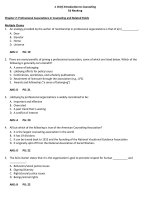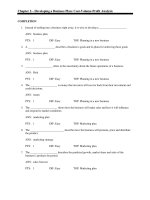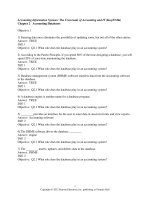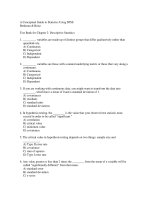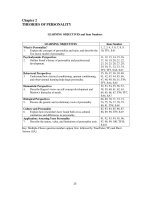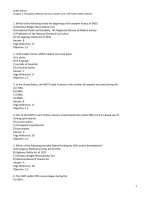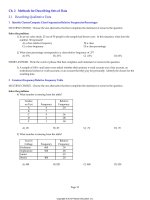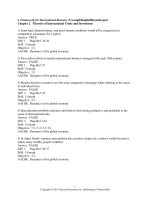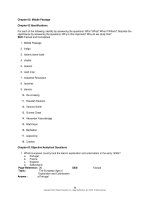A framework of international business 1st edition cavusgil test bank
Bạn đang xem bản rút gọn của tài liệu. Xem và tải ngay bản đầy đủ của tài liệu tại đây (302.89 KB, 66 trang )
A Framework for International Business (Cavusgil/Knight/Riesenberger)
Chapter 2 Theories of International Trade and Investment
1) Farm land, diamond mines, and good climate conditions would all be categorized as
comparative advantages for a region.
Answer: TRUE
Diff: 1
Page Ref: 28-29
Skill: Concept
Objective: 2-1
AACSB: Dynamics of the global economy
2) The earliest efforts to explain international business emerged in the early 20th century.
Answer: FALSE
Diff: 1
Page Ref: 27
Skill: Concept
Objective: 2-1
AACSB: Dynamics of the global economy
3) Modern business executives use the term comparative advantage when referring to the assets
of individual firms.
Answer: FALSE
Diff: 2
Page Ref: 25
Skill: Concept
Objective: 2-1
AACSB: Dynamics of the global economy
4) Specialization prohibits industries and laborers from being productive and profitable in the
arena of international trade.
Answer: FALSE
Diff: 2
Page Ref: 144
Skill: Concept
Objective: 5.1, 5..2, 5.3, 5.4
AACSB: Dynamics of the global economy
5) In Adam Smith's opinion, mercantilism has a positive impact on a nation's wealth because it
makes many wealthy people wealthier.
Answer: FALSE
Diff: 1
Page Ref: 26-27
Skill: Concept
Objective: 2-2
AACSB: Dynamics of the global economy
1
Copyright © 2013 Pearson Education, Inc. Publishing as Prentice Hall
6) In theory, nations which adhere to the absolute advantage principle will have higher standards
of living than nations which follow principles of mercantilism.
Answer: TRUE
Diff: 2
Page Ref: 27
Skill: Concept
Objective: 2-2
AACSB: Dynamics of the global economy
7) Modern globalization is associated with efforts by many governments to develop policies
intended to encourage competitive advantage.
Answer: TRUE
Diff: 1
Page Ref: 31
Skill: Concept
Objective: 2-3
AACSB: Dynamics of the global economy
8) Successful software and computer firms in the United States and India sustain competitive
advantages by investing in research and development.
Answer: TRUE
Diff: 2
Page Ref: 33
Skill: Concept
Objective: 2-3
AACSB: Dynamics of the global economy
9) In the contemporary world of international trade and investment, the most important source of
national advantage is a country's natural resources.
Answer: FALSE
Diff: 2
Page Ref: 31-32
Skill: Concept
Objective: 2-3
AACSB: Dynamics of the global economy
10) National industrial policies typically involve the creation of bureaucratic regulatory systems
which discourage citizens from seeking advanced education.
Answer: FALSE
Diff: 2
Page Ref: 33
Skill: Concept
Objective: 2-3
AACSB: Dynamics of the global economy
11) According to the internationalization process model, internationalization takes place in
incremental stages over a long time.
Answer: TRUE
Diff: 1
Page Ref: 34
Skill: Concept
Objective: 2-4
AACSB: Dynamics of the global economy
2
Copyright © 2013 Pearson Education, Inc. Publishing as Prentice Hall
12) The total value of assets that MNEs own abroad through their investment activities is
measured in FDI stock.
Answer: TRUE
Diff: 1
Page Ref: 34
Skill: Concept
Objective: 2-5
AACSB: Dynamics of the global economy
13) Monopolistic advantage theory is a framework for determining the extent and pattern of
foreign-based value-chain operations.
Answer: FALSE
Diff: 2
Page Ref: 35-36
Skill: Concept
Objective: 2-5
AACSB: Dynamics of the global economy
14) Which of the following industries in Dubai contributes less than 10 percent towards the
nation's GDP?
A) shipping
B) technology
C) financial
D) oil and gas
Answer: D
Diff: 2
Page Ref: 142
Skill: Application
Objective: 5.1, 5..2, 5.3, 5.4
AACSB: Dynamics of the global economy
15) Which of the following features would be considered the primary comparative advantage for
the Persian Gulf nations?
A) petroleum
B) technology
C) infrastructures
D) education
Answer: A
Diff: 1
Page Ref: 25
Skill: Application
Objective: 2-1
AACSB: Dynamics of the global economy
3
Copyright © 2013 Pearson Education, Inc. Publishing as Prentice Hall
16) All of the following are comparative advantages that develop with time except ________.
A) entrepreneurial orientation
B) venture capital availability
C) innovative capacity
D) natural endowments
Answer: D
Diff: 2
Page Ref: 28-29
Skill: Concept
Objective: 2-2
AACSB: Dynamics of the global economy
17) Which of the following statements is a characteristic of a competitive advantage?
A) A competitive advantage is derived from deliberate national policies.
B) A competitive advantage is difficult for competitors to imitate.
C) A competitive advantage is also known as a country-specific advantage.
D) A competitive advantage includes acquired resources, such as labor.
Answer: B
Diff: 3
Page Ref: 25
Skill: Concept
Objective: 2-1
AACSB: Dynamics of the global economy
18) Theories regarding international trade and investment are categorized into which two
groups?
A) classical and national
B) firm-level and comparative
C) nation-level and firm-level
D) competitive and comparative
Answer: C
Diff: 1
Page Ref: 25-26
Skill: Concept
Objective: 2-1
AACSB: Dynamics of the global economy
19) Born globals and firm internationalization are categorized under which of the following
theories of international trade and investment?
A) nation-level theory
B) firm-level theory
C) competitive advantage
D) comparative advantage
Answer: B
Diff: 2
Page Ref: 25
Skill: Concept
Objective: 2-1
AACSB: Dynamics of the global economy
4
Copyright © 2013 Pearson Education, Inc. Publishing as Prentice Hall
20) The idea that exports should be maximized and imports should be minimized is known by
which of the following terms?
A) absolute advantage principle
B) comparative advantage principle
C) factor proportions theory
D) the mercantilist view
Answer: D
Diff: 1
Page Ref: 26
Skill: Concept
Objective: 2-2
AACSB: Dynamics of the global economy
21) Which of the following statements best explains the reason that many economists adhere to
the concept of free trade between nations?
A) Unrestricted international trade increases the prosperity of poor nations.
B) Lower-cost imports reduce the expenses of firms by reducing wages.
C) Domestic product prices tend to remain lower than imported products.
D) Inexpensive exports increase consumer prosperity by reducing expenses.
Answer: A
Diff: 3
Page Ref: 26
Skill: Concept
Objective: 2-2
AACSB: Dynamics of the global economy
22) The idea that each nation is efficient in the production of some goods and less efficient in the
production of other goods underlies which of the following concepts?
A) absolute advantage principle
B) comparative advantage principle
C) factor proportions theory
D) international product cycle theory
Answer: A
Diff: 2
Page Ref: 27
Skill: Concept
Objective: 2-2
AACSB: Dynamics of the global economy
23) Considering the relative efficiency held by nations led to which of the following concepts
regarding the rationale for international trade?
A) monopolistic advantage theory
B) internalization theory
C) absolute advantage principle
D) comparative advantage principle
Answer: D
Diff: 2
Page Ref: 28
Skill: Concept
Objective: 2-2
AACSB: Dynamics of the global economy
5
Copyright © 2013 Pearson Education, Inc. Publishing as Prentice Hall
24) All of the following statements characterize the comparative advantage principle except
________.
A) the principle provides the foundation for modern international trade
B) cost of production is less important than the ratio of production
C) the exportation of labor-intensive goods should be emphasized
D) nations can trade profitably even if manufacturing costs are high
Answer: C
Diff: 3
Page Ref: 28-29
Skill: Concept
Objective: 2-2
AACSB: Dynamics of the global economy
25) Modern international trade is hindered by all of the following except ________.
A) shipping
B) tariffs
C) regulations
D) technology
Answer: D
Diff: 1
Page Ref: 29
Skill: Concept
Objective: 2-2
AACSB: Dynamics of the global economy
26) According to the factor proportions theory, nations with an ample labor supply of low-skill
labor, such as Mexico, should ________.
A) export wheat and import toys
B) export automobiles and import wool
C) export textiles and import pharmaceuticals
D) export beef and import electronics
Answer: C
Diff: 2
Page Ref: 30
Skill: Concept
Objective: 2-2
AACSB: Dynamics of the global economy
27) Which of the following was the analysis revealed by the Leontief paradox in the 1950s?
A) Despite an abundant pool of labor, the U.S. was exporting capital-intensive goods.
B) Despite having abundant capital, the U.S. was exporting labor-intensive goods.
C) Despite plentiful natural resources, the U.S. was importing oil and gas.
D) Despite a large agricultural network, the U.S. was importing grains.
Answer: B
Diff: 3
Page Ref: 30
Skill: Concept
Objective: 2-2
AACSB: Dynamics of the global economy
6
Copyright © 2013 Pearson Education, Inc. Publishing as Prentice Hall
28) According to the international product cycle theory, inventors of a product earn the most
profits at which of the following stages?
A) evolution
B) introduction
C) growth
D) maturity
Answer: B
Diff: 2
Page Ref: 30
Skill: Concept
Objective: 2-2
AACSB: Dynamics of the global economy
29) Which of the following is not an element of Porter's Diamond Model?
A) firm strategy, structure, and rivalry
B) demand conditions
C) quality of production
D) factor conditions
Answer: C
Diff: 2
Page Ref: 32-33
Skill: Concept
Objective: 2-3
AACSB: Dynamics of the global economy
30) All of the following are methods of innovation used by companies except ________.
A) design modifications
B) marketing alterations
C) production changes
D) capital outlays
Answer: D
Diff: 2
Page Ref: 32
Skill: Concept
Objective: 2-3
AACSB: Dynamics of the global economy
31) A nation's factor endowments help determine which of the following?
A) national competitive advantage
B) demand conditions
C) national comparative advantage
D) industrial clusters
Answer: A
Diff: 1
Page Ref: 32
Skill: Concept
Objective: 2-3
AACSB: Dynamics of the global economy
7
Copyright © 2013 Pearson Education, Inc. Publishing as Prentice Hall
32) Northern Italy is recognized as a(n) ________ for the fashion industry.
A) economic hub
B) industrial cluster
C) competitive advantage
D) diamond model
Answer: B
Diff: 1
Page Ref: 33
Skill: Concept
Objective: 2-3
AACSB: Dynamics of the global economy
33) Which of the following statements would be supported by Michael Porter?
A) Economic prosperity depends on inherited national advantages.
B) Company structure inhibits creativity and competition.
C) Excessive competition drives focal firms to rival nations.
D) Rivalry among industry competitors spurs innovation.
Answer: D
Diff: 3
Page Ref: 32
Skill: Critical Thinking
Objective: 2-3
AACSB: Dynamics of the global economy; Reflective thinking skills
34) The collaboration between public and private sectors in an attempt to initiate economic
development is known by which of the following terms?
A) national endowment policy
B) national fiscal policy
C) national industrial policy
D) national globalization policy
Answer: C
Diff: 2
Page Ref: 33
Skill: Concept
Objective: 2-3
AACSB: Dynamics of the global economy
35) An industrial cluster can best be described as ________.
A) factories and their support systems in a particular location
B) a synergy of various firms and suppliers
C) Silicon Valley
D) a concentration of supporting factors in the same industry in one place
Answer: D
Diff: 2
Page Ref: 33
Skill: Application
Objective: 2-3
AACSB: Dynamics of the global economy
8
Copyright © 2013 Pearson Education, Inc. Publishing as Prentice Hall
36) How do nations that lack natural or other resources compete in international business and
trade?
A) Governments continue to encourage the export of goods and services that have been
historically profitable.
B) Competitive advantages are initiated by multinational focal firms that manufacture products
in impoverished nations.
C) Nations create their own competitive advantages by investing in education, industry, and
infrastructures.
D) National industries are created and large public works projects are initiated to create
employment opportunities.
Answer: C
Diff: 3
Page Ref: 33
Skill: Concept
Objective: 2-3
AACSB: Dynamics of the global economy
37) A comparative advantage is also called a(n) ________.
A) country advantage
B) location-specific advantage
C) inexpensive benefit capability
D) innovative capacity
Answer: B
Diff: 3
Page Ref: 31
Skill: Concept
Objective: 2-3
AACSB: Dynamics of the global economy; Reflective thinking skills
38) In internationalization process of a firm, what is the simplest form of international activity?
A) importing technology
B) exporting products
C) planning and research
D) establishing an overseas presence
Answer: B
Diff: 2
Page Ref: 34
Skill: Concept
Objective: 2-4
AACSB: Dynamics of the global economy
9
Copyright © 2013 Pearson Education, Inc. Publishing as Prentice Hall
39) In the internationalization process, most firms do not engage in ________.
A) export activity
B) foreign marketing
C) cross-border transactions
D) extensive analysis and planning
Answer: D
Diff: 1
Page Ref: 34
Skill: Concept
Objective: 2-4
AACSB: Dynamics of the global economy
40) What is suggested by the increasing number of early internationalizing focal firms?
A) Born globals will become typical in the world of international trade.
B) The size of born globals cannot sustain the rigors of international trade.
C) Competition among born globals will eliminate multinational enterprises.
D) The economic stability of born globals threatens international trade.
Answer: A
Diff: 3
Page Ref: 34
Skill: Concept
Objective: 2-4
AACSB: Dynamics of the global economy
41) The importance of multinational enterprises on international trade and business ranks as a(n)
________.
A) development with much the same impact as the availability of electric power
B) historic event
C) invention not unlike manned flight
D) all of the above
Answer: D
Diff: 2
Page Ref: 34
Skill: Concept
Objective: 2-5
AACSB: Dynamics of the global economy
42) Which theory supports the idea that a firm chooses FDI as an entry strategy because an MNE
can operate foreign subsidiaries more profitably than a local firm?
A) factor proportions theory
B) eclectic paradigm
C) internalization theory
D) monopolistic advantage theory
Answer: D
Diff: 2
Page Ref: 34-35
Skill: Concept
Objective: 2-5
AACSB: Dynamics of the global economy
10
Copyright © 2013 Pearson Education, Inc. Publishing as Prentice Hall
43) Which of the following is a benefit of internalizing foreign-based value-chain activities?
A) The MNE maintains a monopolistic presence in foreign countries.
B) The MNE eliminates the expense of freight forwarders and customs brokers.
C) The MNE oversees control of foreign operations and ensures product quality.
D) The MNE learns new manufacturing methods from foreign partners.
Answer: C
Diff: 3
Page Ref: 36
Skill: Application
Objective: 2-5
AACSB: Dynamics of the global economy
44) Which of the following is considered an important monopolistic advantage?
A) physical assets
B) skilled labor
C) inexpensive capital
D) proprietary knowledge
Answer: D
Diff: 1
Page Ref: 35
Skill: Concept
Objective: 2-5
AACSB: Dynamics of the global economy
45) All of the following are typical examples of ownership-specific advantages except
________.
A) marketing skills
B) natural resources
C) economies of scale
D) trademarks
Answer: B
Diff: 2
Page Ref: 37
Skill: Application
Objective: 2-5
AACSB: Dynamics of the global economy
46) Which of the following terms is used to refer to a collaborative venture which results in a
new legal entity?
A) strategic alliance
B) collaborative partnership
C) joint venture
D) equity consortium
Answer: C
Diff: 1
Page Ref: 38
Skill: Concept
Objective: 2-5
AACSB: Dynamics of the global economy
11
Copyright © 2013 Pearson Education, Inc. Publishing as Prentice Hall
47) Networks are relational assets that are conducted with all of the following entities except
________.
A) government and consultants
B) buyers and sellers
C) suppliers and distributors
D) none of the above
Answer: D
Diff: 3
Page Ref: 38
Skill: Concept
Objective: 2-5
AACSB: Dynamics of the global economy
Mercantilism Assignment (Scenario)
The final assignment for Daniel Parilla's international business class involves taking an in-depth
look at one of the five classical perspectives that explain the rationale for international trade.
Daniel plans to present an argument in favor of mercantilism. Daniel will be attempting to
convince his classmates that mercantilism leads to national prosperity. Daniel's peers will be
given opportunities to counter his argument.
48) One of Daniel's classmates most likely counters Daniel's argument with which of the
following statements?
A) Restrictions on exports would lead to higher prices and possibly inflation.
B) Exporting firms would lose money due to the limited number of foreign consumers.
C) Consumers would be harmed by high prices and the lack of product choices.
D) Labor unions would demand higher wages and unemployment would increase.
Answer: C
Diff: 3
Page Ref: 144
Skill: Critical Thinking
Objective: 6-2
AACSB: Dynamics of the global economy; Reflective thinking skills
49) Classmates in favor of free trade over mercantilism would most likely cite which of the
following reasons?
A) Free trade increases the standard of living by reducing consumer expenses.
B) Consumers faced with numerous product choices will spend more money.
C) Focal firms benefit from free trade because they can export more goods.
D) Free trade allows firms to raise prices and reach more international consumers.
Answer: A
Diff: 3
Page Ref: 144
Skill: Critical Thinking
Objective: 6-2
AACSB: Dynamics of the global economy; Reflective thinking skills
12
Copyright © 2013 Pearson Education, Inc. Publishing as Prentice Hall
Kazmia Revitalization (Scenario)
The leaders of Kazmia, a small nation in the southern hemisphere, have called a meeting to
discuss ways to encourage foreign firms to invest in Kazmia. The country was once a leader in
diamond mining and exports; however, the diamond mines have been depleted. Meanwhile the
standard of living in Kazmia has plummeted to its lowest level, and young people are fleeing the
country. Government leaders must devise a plan to reinvigorate the once prosperous nation.
50) The work of which of the following experts would be the most helpful to the leaders of
Kazmia in their efforts to reinvent their country?
A) Raymond Vernon
B) Paul Krugman
C) John Dunning
D) Michael Porter
Answer: D
Diff: 2
Page Ref: 31--32
Skill: Application
Objective: 2-3
AACSB: Dynamics of the global economy
51) The first stage of creating a competitive advantage for Kazmia will most likely involve
which of the following?
A) developing public works projects
B) redeveloping the country's diamond mines
C) creating a national industrial policy
D) creating a marketing campaign to attract young people back to Kazmia
Answer: C
Diff: 2
Page Ref: 33
Skill: Application
Objective: 2-3
AACSB: Dynamics of the global economy
52) Which of the following actions by the government would be the most beneficial for the longterm economic security of Kazmia?
A) encouraging renewed investment in the mining industry
B) developing an infrastructure of communications, technology, and transportation
C) discouraging trade relations until the nation is fiscally stable
D) passing laws and establishing regulatory systems to monitor MNE activities
Answer: B
Diff: 3
Page Ref: 33
Skill: Application
Objective: 2-3
AACSB: Dynamics of the global economy
13
Copyright © 2013 Pearson Education, Inc. Publishing as Prentice Hall
53) Which of the following countries would provide the best example for Kazmia for achieving
substantial national competitive advantage?
A) Britain
B) Guatemala
C) Spain
D) North Korea
Answer: A
Diff: 2
Page Ref: 32
Skill: Application
Objective: 2-3
AACSB: Dynamics of the global economy
Earth-Rite Organic Foods (Scenario)
Earth-Rite Organic Foods is an MNE based in Sweden with subsidiaries located in numerous
countries around the world. Earth-Rite has annual sales of $40 billion dollars and employs more
than 90,000 individuals worldwide. Earth-Rite currently dominates the organic food industry, but
competitors are beginning to catch up because of a growing demand for organic food. Earth-Rite
is considering a "collaborative venture" with a small chain of organic grocery stores located in
Brazil, a country where Earth-Rite has no stores.
54) Which of the following would be most important for Earth-Rite executives to consider when
deciding whether to collaborate with the Brazilian grocery store chain?
A) How much money will Earth-Rite save on advertising by entering a joint venture?
B) Will a collaborative venture enable Earth-Rite to internationalize rapidly in Brazil?
C) What is the density of international trade facilitators in Brazil?
D) Who will be responsible for training grocery store employees in Brazil?
Answer: B
Diff: 3
Page Ref: 38
Skill: Critical Thinking
Objective: 2-5
AACSB: Dynamics of the global economy; Reflective thinking skills
55) Which of the following would be a benefit for Earth-Rite if the MNE entered into a joint
venture with the Brazilian grocery store chain?
A) low risks because no equity would be committed
B) simplified international value-chain activity
C) access to the Brazilian store's extensive assets
D) ease of navigation through foreign distribution channels
Answer: D
Diff: 2
Page Ref: 38
Skill: Application
Objective: 2-5
AACSB: Dynamics of the global economy
14
Copyright © 2013 Pearson Education, Inc. Publishing as Prentice Hall
56) In a short essay, describe the two leading theories of international trade and investment.
What do economists and scholars hope to learn from an analysis of international trade and
investment?
Answer: Two theories exist regarding international trade and investment. The first group
includes nation-level theories. These are classical theories that have been advocated primarily
since the 18th century. The second group includes firm-level theories. These are more
contemporary theories of how firms can create and sustain superior market position.
Economists, managers, and academic scholars have offered both classical and contemporary
theories in hopes of determining the economic rationale for international trade and investment.
They debate why nations should promote trade and investment with other nations and also how
nations create and sustain comparative advantage.
Diff: 2
Page Ref: 24-26
Skill: Concept
Objective: 2-1
AACSB: Dynamics of the global economy
57) In a short essay, explain what the world would be like without international trade.
Answer: Without international trade, most nations would be unable to feed, clothe, and house
their citizens at current levels. Even resource-rich countries like the United States would suffer
immensely without trade. Some types of food would become unavailable or obtainable only at
very high prices. Coffee and sugar would become luxury items. Petroleum-based energy sources
would dwindle. Vehicles would stop running, freight would go undelivered, and people would
not be able to heat their homes in the wintertime. In short, not only do nations, companies and
citizens benefit from international trade, modern life is virtually impossible without it.
Diff: 2
Page Ref: 144
Skill: Concept
Objective: 6-2
AACSB: Dynamics of the global economy
15
Copyright © 2013 Pearson Education, Inc. Publishing as Prentice Hall
58) In a short essay, contrast the theory of mercantilism with the theory of free trade. Why is free
trade preferred by most modern nations?
Answer:
a.
Mercantilism suggests that exports are good and imports are bad. Mercantilists believed
that national prosperity results from a positive balance of trade, achieved by maximizing exports
and minimizing imports. They argued that the nation's power and strength increase as its wealth
increases. In essence, mercantilism underlies the rationale for a nation's attempt to run a trade
surplus, that is, to export more goods than it imports.
b.
Free-trade advocates the relative absence of restrictions to flow of goods and services
between nations. Although some groups, such as labor unions and farmers, support neomercantilism, free trade is the preferred choice by most nations for a number of reasons.
c.
Free trade is advocated because consumers and firms can more readily buy the products
they want. The prices of imported products tend to be lower than for domestically produced
products (because access to world-scale supplies forces prices down, mainly from increased
competition; or because the goods are produced in lower-cost countries). Lower-cost imports
help reduce the expenses of firms, thereby raising their profits (which may be passed on to
workers in the form of higher wages). Lower-cost imports help reduce the expenses of
consumers, thereby increasing their living standards. Unrestricted international trade generally
increases the overall prosperity of poor countries.
Diff: 3
Page Ref: 26
Skill: Concept
Objective: 2-2
AACSB: Dynamics of the global economy
59) In a short essay, explain the "Absolute Advantage principle". Provide an example of the
principle at work.
Answer: Adam Smith's absolute advantage principle states that each country benefits by
producing only those products in which it has an absolute advantage, allowing it to specialize in
those products that it can produce at a lower cost than other countries and exporting them, and
then importing other products it needs. Thus, each country increases its welfare by specializing
in the production of certain products and importing others.
A modern example of the principle at work involves the nations of Japan and Saudi Arabia.
Japan has no natural holdings of oil, but it manufactures some of the best automobiles in the
world. On the other hand, Saudi Arabia produces much oil, but it lacks a substantial car industry.
Given the state of their resources, it would be wasteful for each of these countries to attempt to
produce both oil and cars. By trading with each other, Japan and Saudi Arabia each employs its
respective resources efficiently in a mutually beneficial relationship. Japan gets oil that it refines
to power its cars, and Saudi Arabia gets the cars needed by its citizens. Because each country
uses its own resources with optimum efficiency and engages in trade, living standards for its
citizens are higher than they would be if they had not engaged in trade.
Diff: 2
Page Ref: 27
Skill: Concept
Objective: 2-2
AACSB: Dynamics of the global economy
16
Copyright © 2013 Pearson Education, Inc. Publishing as Prentice Hall
60) How does opportunity cost relate to comparative advantage? In a short essay, explain the
connection between the two terms and provide an example for illustration.
Answer: The comparative advantage principle states that it can be beneficial for two countries to
trade without barriers as long as one is more efficient at producing goods or services needed by
the other. What matters is not the absolute cost of production, but rather the relative efficiency
with which a country can produce the product. One way to understand the concept of
comparative advantage is to consider opportunity cost, the cost of something in terms of a
forgone alternative activity.
For example, if Germany decided to devote all labor resources to producing wheat, it would
automatically forego the opportunity to produce cloth. In relative terms, the opportunity cost to
Germany of producing wheat is higher than the opportunity cost of producing cloth because
Germany can produce cloth more efficiently (and therefore in greater relative quantity) than
wheat. The opportunity cost to France of producing cloth is higher than the opportunity cost of
producing wheat because France can produce wheat more efficiently (and therefore in greater
relative quantity) than cloth. By specializing in what they produce best and trading for the rest,
for a given level of labor cost, Germany and France can each produce and consume relatively
more of the goods that it desires.
Diff: 3
Page Ref: 145-147
Skill: Concept
Objective: 6-2
AACSB: Dynamics of the global economy
61) In a short essay, explain the factor proportions theory and provide an example for illustration
purposes. How does the theory differ from other international trade theories?
Answer: The factor proportions theory rests on two premises: First, products differ in the types
and quantities of factors (that is, labor, natural resources, and capital) that are required for their
production; and second, countries differ in the type and quantity of production factors that they
possess. Thus, according to this theory, each country should export products that use intensively
its relatively abundant factors of production, and import goods that use intensively its relatively
scarce factors of production.
For example, the U.S. produces and exports capital-intensive products, such as pharmaceuticals
and commercial aircraft, while Russia produces land-intensive products, such as wheat.
Factor proportions theory differs somewhat from earlier trade theories by emphasizing the
importance of each nation's factors of production. The theory states that, in addition to
differences in the efficiency of production, differences in the quantity of factors of production
held by countries also determine international trade patterns. Originally labor was seen as the
most important factor of production.
Diff: 3
Page Ref: 30
Skill: Concept
Objective: 2-2
AACSB: Dynamics of the global economy
17
Copyright © 2013 Pearson Education, Inc. Publishing as Prentice Hall
62) What is the connection between the competitive advantage of a firm and the competitive
advantage of a nation? In a short essay, explain the nature of the relationship between firms and
nations.
Answer: The innovative capacity of a nation derives from the collective innovative capacity of
its firms. The more innovative firms a nation has, the stronger that nation's competitive
advantage. Innovation also promotes productivity, the value of the output produced by a unit of
labor or capital. The more productive a company is, the more efficiently it uses its resources. The
more productive the firms in a nation are, the more efficiently the nation uses its resources. At
the national level, productivity is a key determinant of the nation's long-run standard of living
and a basic source of national per-capita (per person) income growth.
Diff: 2
Page Ref: 31-32
Skill: Concept
Objective: 2-3
AACSB: Dynamics of the global economy
63) In a short essay, explain why the comparative advantage principle is the foundation and
overriding justification for international trade. How does this principle support the competitive
advantage of nations theory?
Answer: British political economist David Ricardo explained why it is beneficial for two
countries to trade even though one of them may have absolute advantage in the production of all
products. Ricardo demonstrated that what matters is not the absolute cost of production, but
rather the relative efficiency with which the two countries can produce the products. Hence, the
comparative advantage principle states that it can be beneficial for two countries to trade
without barriers as long as one is relatively more efficient at producing goods or services needed
by the other. The principle of comparative advantage is the foundation and overriding
justification for international trade.
This principle supports the competitive advantage of nations theory. Just as scholars recognized
that international business is good for individual nations, they increasingly sought to explain how
nations can position themselves for international business success. An important contribution
came from Michael Porter. According to Porter, the competitive advantage of a nation depends
on the collective competitive advantages of the nation's firms. Over time, this relationship is
reciprocal: The competitive advantages held by the nation tend to drive the development of new
firms and industries with these same competitive advantages.
Diff: 2
Page Ref: 28, 31-33
Skill: Synthesis
Objective: 2-2, 2-3
AACSB: Dynamics of the global economy
18
Copyright © 2013 Pearson Education, Inc. Publishing as Prentice Hall
64) In a short essay, explain what appears to be the current trend in international business.
Answer: The current trend is the widespread emergence of firms that internationalize at their
founding ─ born globals ─ and the rise of a new field of scholarly inquiry, international
entrepreneurship. Despite the scarcity of financial, human, and tangible resources that
characterize most new businesses, born globals progress to internationalization early in their
evolution. Current trends imply that early internationalizing firms will gradually become the
norm in international trade and investment.
Diff: 2
Page Ref: 34
Skill: Concept
Objective: 2-4
AACSB: Dynamics of the global economy
19
Copyright © 2013 Pearson Education, Inc. Publishing as Prentice Hall
65) In a short essay, explain the international product life cycle theory and the
internationalization process model. Discuss the ways in which these models describe how
companies expand abroad.
Answer: In a 1966 article, Harvard Professor Raymond Vernon sought to explain international
trade based on the evolutionary process that occurs in the development and diffusion of products
to markets around the world. In his International Product Life Cycle (IPLC) Theory, Vernon
observed that each product and its manufacturing technologies go through three stages of
evolution: introduction, maturity, and standardization.
In the introduction stage, a new product typically originates in an advanced economy, such as the
United States. During the introduction stage, the new product is produced in the home country,
which enjoys a temporary monopoly.
As the product enters the maturity phase, the product's inventors mass-produce it and seek to
export it to other advanced economies. Gradually, however, the product's manufacturing
becomes more routine and foreign firms begin producing alternative versions, ending the
inventor's monopoly power. At this stage, as competition intensifies and export orders begin to
come from lower-income countries, the inventor may earn only a narrow profit margin.
In the standardization phase, knowledge about how to produce the product is widespread and
manufacturing has become straightforward. Early in the product's evolution, production required
specialized workers skilled in R&D and manufacturing. Once standardized, however, mass
production is the dominant activity and can be accomplished using cheaper inputs and low-cost
labor and, eventually, the country that invented the product becomes a net importer. It and other
advanced economies become saturated with imports of the good from developing economies. In
effect, exporting the product has caused its underlying technology to become widely known and
standardized around the world.
In comparison, the internationalization process model was developed in the 1970s to describe
how companies expand abroad. According to this model, internationalization takes place in
incremental stages over a long time. Typically, firms start without much analysis or planning and
begin to export, the simplest form of international activity, and progress to FDI, the most
complex. The gradual and incremental nature of internationalization often results from managers'
uncertainty and uneasiness about how to proceed, because they lack information about foreign
markets and experience with cross-border transactions.
Diff: 2
Page Ref: 149, 157-158
Skill: Synthesis
Objective: 2-2, 2-4
AACSB: Dynamics of the global economy
20
Copyright © 2013 Pearson Education, Inc. Publishing as Prentice Hall
66) Explain the limitations of early trade theories, and discuss why born global firms exemplify a
contemporary trade approach.
Answer: While the concepts of absolute advantage and comparative advantage provide the
rationale for international trade, these early trade theories fail to account for factors that make
contemporary trade complex, including the following:
• Traded products are not just commodities anymore; many traded goods are characterized by
strong branding and differentiated features.
• International transportation is often costly.
• Government restrictions such as tariffs (taxes on imports), import barriers, and regulations can
hamper international trade.
• Large-scale production in certain industries may bring about scale economies, and therefore
lower prices.
• Many services, such as banking and retailing, cannot be traded in the usual sense and must be
internationalized via foreign direct investment.
• Modern telecommunications and the Internet facilitate global trade in many services at very
low cost.
• Many firms are highly entrepreneurial and innovative or have access to exceptional human
talent that they employ to develop superior business strategies.
Despite the scarcity of financial, human, and tangible resources that characterize most new
businesses, born global firms internationalize early in their evolution. Among the reasons are the
growing intensity of international competition, the integration of world economies under
globalization, and advances in communication and transportation technologies that reduce the
cost of venturing abroad and make it easier to internationalize earlier and faster than ever before.
The born global phenomenon has given rise to a new field of scholarly inquiry, international
entrepreneurship. Current trends suggest that early internationalizing firms will gradually
become the norm in international business.
Diff: 2
Page Ref: 29, 34
Skill: Synthesis
Objective: 2-2, 2-4
AACSB: Dynamics of the global economy
21
Copyright © 2013 Pearson Education, Inc. Publishing as Prentice Hall
67) Why do some MNEs enter international markets through Foreign Direct Investment (FDI)
instead of through exporting? In a short essay, explain why P&G chose FDI-based entry. How
does FDI-based entry relate to internalization theory?
Answer: Before Procter & Gamble entered Japan, management considered exporting and FDI.
With exporting, P&G would have had to contract with an independent Japanese distributor to
handle warehousing and marketing of soap, detergent, diapers, and the other products that P&G
now sells in Japan. Ultimately, P&G chose instead to enter Japan via FDI. P&G established its
own marketing subsidiary and, eventually, national headquarters in Tokyo. Such an arrangement
provided various benefits for P&G, such as how its products were marketed in Japan and to
minimize the risk of its proprietary knowledge being dissipated to potential Japanese
competitors.
This example of P&G in Japan reveals how MNEs internalize key business functions and assets
within the corporate organization. Internalization theory explains the process by which firms
acquire and retain one or more value-chain activities inside the firm, minimizing the
disadvantages of dealing with external partners and allowing for greater control over foreign
operations. By internalizing foreign-based value-chain activities, it is the firm, rather than its
products, that crosses international borders. The MNE is ultimately a vehicle for bypassing the
bottlenecks and costs of the international, interfirm exchange of goods, materials, and workers.
In this way, the MNE replaces business activities it performs itself.
Diff: 3
Page Ref: 35-36
Skill: Concept
Objective: 2-5
AACSB: Dynamics of the global economy
22
Copyright © 2013 Pearson Education, Inc. Publishing as Prentice Hall
68) According to Dunning's eclectic paradigm, an MNE must meet three conditions before
successfully entering a foreign market via foreign direct investment (FDI). Explain these
conditions in a short essay.
Answer:
a.
The MNE must possess ownership-specific advantages relative to other firms in the
market—that is, knowledge, skills, capabilities, key relationships, and other assets that allow it to
compete effectively in foreign markets. These assets amount to the firm's competitive
advantages. The notion of ownership-specific advantages is related to monopolistic advantage
theory.
b.
The firm must have access to location-specific advantages, the comparative advantages
available in individual foreign countries, such as natural resources, skilled labor, low-cost labor,
and inexpensive capital.
c.
The MNE must have internalization advantages, benefits it derives from internalizing
foreign-based manufacturing, distribution, or other stages in its value chain. When profitable, the
firm will transfer its ownership-specific advantages across national borders within its own
organization rather than dissipating them to independent, foreign entities, such as distributors and
other autonomous intermediaries abroad.
Diff: 2
Page Ref: 37-38
Skill: Concept
Objective: 2-5
AACSB: Dynamics of the global economy
23
Copyright © 2013 Pearson Education, Inc. Publishing as Prentice Hall
69) In a short essay, explain mercantilism and the monopolistic advantage theory.
Answer: Mercantilism argues that national prosperity results from a positive balance of trade
achieved by maximizing exports and minimizing or even impeding imports.
In essence, mercantilism explains why nations attempt to run a trade surplus—that is, to export
more goods than they import. Even today many people believe that running a trade surplus is
beneficial. They subscribe to a view known as neo-mercantilism. Labor unions (which seek to
protect home-country jobs), farmers (who want to keep crop prices high), and certain
manufacturers (those that rely heavily on exports) all tend to support neo-mercantilism.
On the other hand, mercantilism tends to harm the interests of firms that import, especially those
that import raw materials and parts used in the manufacture of finished products. Mercantilism
also harms the interests of consumers, because restricting imports reduces the choice of products
they can buy. Product shortages that result from import restrictions may lead to higher prices—
that is, inflation. When taken to an extreme, mercantilism may invite "beggar thy neighbor"
policies, promoting the benefits of one country at the expense of others.
A monopolistic advantage is one or more resources or capabilities a company possesses that few
other firms have and that it leverages to generate profits and other returns. Monopolistic
advantage theory suggests that firms which use FDI as an internationalization strategy must own
or control certain resources and capabilities not easily available to competitors, that give them a
degree of monopoly power over local firms in foreign markets.
Diff: 2
Page Ref: 26, 35-35
Skill: Synthesis
Objective: 2-2, 2-5
AACSB: Dynamics of the global economy
70) Collaborative ventures became a popular entry strategy in the 1980s. Describe the two major
types of international collaborative ventures and explain the benefits of this internationalization
approach.
Answer: A collaborative venture is a form of cooperation between two or more firms.
Collaborative ventures are classified into two major types: equity-based joint ventures that result
in the formation of a new legal entity; and project-based strategic alliances that do not require
equity commitment from the partners but simply a willingness to cooperate in R&D,
manufacturing, design, or any other value-adding activity. In both cases, collaborating firms pool
resources and capabilities and share risks to carry out activities that each might be unable to
perform on its own.
Diff: 2
Page Ref: 38
Skill: Concept
Objective: 2-5
AACSB: Dynamics of the global economy
24
Copyright © 2013 Pearson Education, Inc. Publishing as Prentice Hall
PART 1: FOUNDATION CONCEPTS
CHAPTER 1
WHAT IS INTERNATIONAL BUSINESS?
Instructor’s Manual by Marta Szabo White, Ph.D.
I. LECTURE STARTER/LAUNCHER
DAY ONE
• Start and stop the class on time.
• Introduce yourself! Talk about yourself and your passion about teaching.
• Get to know each of your students and ask for their specific expectations for the class.
• Use icebreakers on first day of class.
• Go over the syllabus. It is the “contract” between you and the student; the more detailed,
the better.
• Lay out your expectations clearly from the outset! What are your classroom rules?
Establish your credentials and authority.
■ Consider having everyone in class introduce him or herself. One way to initiate introductions
is to distribute random pages torn from business magazines, in which each person receives one
page. Next each student circles words on the page that describe him/her. In groups of two or
three, each student shares the rationale behind each word that he/she circled. Finally, one of the
group members introduces another group member to the class. This process enables students to
immediately know at least one other student in the class. The circled words and explanations are
often humorous, which serve as icebreakers during your first classroom encounter.
■ GlobalEDGE (globaledge.msu.edu) assembles a collection of tools and games that will allow
you to compare countries on a variety of statistical indicators, rank countries based on these
indicators, and test your knowledge of country capitals from around the world.
/>■ Under Country Insights click on a region, then select a country, Zimbabwe for example.
/>Currency Converter
Country Comparator
Country Rankings
Country Commercial Guide
World Bank Doing Business Indicators
BBC Country Profile
Everyone in the class should be assigned a different country. Each student is then responsible for
becoming an expert on that country. Twice during the term, each student could report on their
country and summarize a newspaper article published in their country, i.e., an International
Newspaper Memorandum assignment.
1
Copyright © 2013 Pearson Education, Inc. publishing as Prentice Hall
